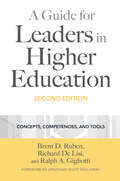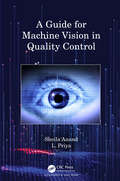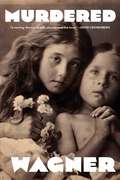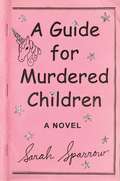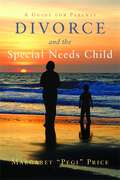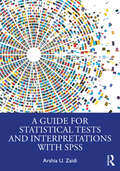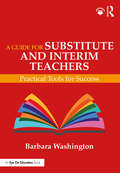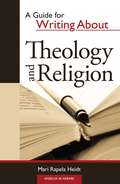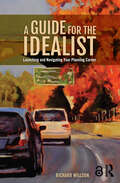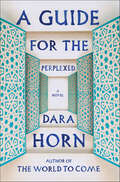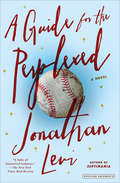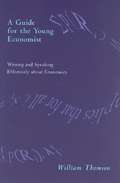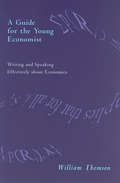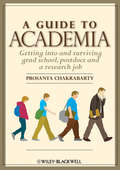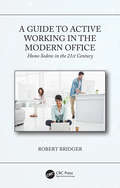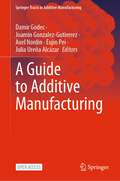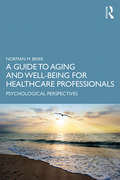- Table View
- List View
A Guide for Leaders in Higher Education: Concepts, Competencies, and Tools
by Ralph A. Gigliotti Brent D. Ruben Richard De LisiFIRST EDITION SPECIAL RECOGNITION:Winner of the 2018 Sue DeWine Distinguished Scholarly Book Award, National Communication Association, Applied Communication Division REVIEWS OF THE FIRST EDITION“The book provides frameworks and resources that would be highly relevant for new and aspiring department chairs. In fact, this text is ideally designed to serve as a selection for a book discussion group.”—The Department Chair“Succeeds in providing accessible and useful resources to individuals across different leadership roles… As a midpoint between textbook and reference work, it is successful at both and provides a clear and unbiased background to issues facing current leaders.”—Reflective TeachingDuring a time of unprecedented challenges facing higher education, the need for effective leadership – for informal and formal leaders across the organization – has never been more imperative.Since publication of the first edition, the environment for higher education has become more critical and complex. Whether facing falling enrollments, questions of economic sustainability, the changing composition of the faculty and student bodies, differential retention and graduation rates, declining public confidence in the enterprise, or the rise in the use of virtual technologies – not to mention how COVID-19 and an intensified focus on long standing issues of racial and gender representation and equity have impacted institutions and challenged many long-standing assumptions – it is clear that learning on the job no longer suffices. Leadership development in higher education has become essential for advancing institutional effectiveness, which is the focus of this book.Taking into account the imperative issues of diversity, inclusion, and belonging, and the context of institutional mission and culture, this book centers on developing capacities for designing and implementing plans, strategies, and structures; connecting and engaging with colleagues and students; and communicating and collaborating with external constituencies in order to shape decisions and policies. It highlights the need to think broadly about the purposes of higher education and the dynamics of organizational excellence, and to apply these insights effectively in goal setting, planning and change leadership, outcomes assessment, addressing crises, and continuous improvement at both the level of the individual and organization.The concepts and tools in this book are equally valuable for faculty and staff leaders, whether in formal leadership roles, such as deans, chairs, or directors of institutes, committees, or task forces, or those who perform informal leadership functions within their departments, disciplines, or institutions. It can be used as a professional guide, a textbook in graduate courses, or as a resource in leadership training and development programs. Each chapter concludes with a series of case studies and guiding questions.
A Guide for Machine Vision in Quality Control
by Sheila Anand L. PriyaMachine Vision systems combine image processing with industrial automation. One of the primary areas of application of Machine Vision in the Industry is in the area of Quality Control. Machine vision provides fast, economic and reliable inspection that improves quality as well as business productivity. Building machine vision applications is a challenging task as each application is unique, with its own requirements and desired outcome. A Guide to Machine Vision in Quality Control follows a practitioner’s approach to learning machine vision. The book provides guidance on how to build machine vision systems for quality inspections. Practical applications from the Industry have been discussed to provide a good understanding of usage of machine vision for quality control. Real-world case studies have been used to explain the process of building machine vision solutions. The book offers comprehensive coverage of the essential topics, that includes: Introduction to Machine Vision Fundamentals of Digital Images Discussion of various machine vision system components Digital image processing related to quality control Overview of automation The book can be used by students and academics, as well as by industry professionals, to understand the fundamentals of machine vision. Updates to the on-going technological innovations have been provided with a discussion on emerging trends in machine vision and smart factories of the future. Sheila Anand is a PhD graduate and Professor at Rajalakshmi Engineering College, Chennai, India. She has over three decades of experience in teaching, consultancy and research. She has worked in the software industry and has extensive experience in development of software applications and in systems audit of financial, manufacturing and trading organizations. She guides Ph.D. aspirants and many of her research scholars have since been awarded their doctoral degree. She has published many papers in national and international journals and is a reviewer for several journals of repute. L Priya is a PhD graduate working as Associate Professor and Head, Department of Information Technology at Rajalakshmi Engineering College, Chennai, India. She has nearly two decades of teaching experience and good exposure to consultancy and research. She has delivered many invited talks, presented papers and won several paper awards in International Conferences. She has published several papers in International journals and is a reviewer for SCI indexed journals. Her areas of interest include Machine Vision, Wireless Communication and Machine Learning.
A Guide for Murdered Children
by Bruce Wagner"In her astonishing thriller, Sarah Sparrow has joined the ranks of Shirley Jackson and Stephen King. A warning: there is no safe place to read this book." –David Cronenberg Originally Published under the name Sarah Sparrow, Bruce Wagner's A Guide for Murdered Children is terrifying, thoroughly original, and hauntingly written. Ex-NYPD detective Willow Wylde is fresh out of rehab and finally able to find a job running a Cold Case squad in suburban Detroit. When the two rookie cops assigned to him take an obsessive interest in a decades-old disappearance of a brother and sister, Willow begins to suspect something out of the ordinary is afoot. He uncovers a series of church basement AA-type meetings made up of the slain innocents and a new way of looking at life, death, murder—and missed opportunities—is revealed to him. A Guide for Murdered Children is a genre-busting, mind-bending twist on the fine line between the ordinary . . . and the unfathomable.
A Guide for Murdered Children: A Novel
by Sarah Sparrow"In her astonishing thriller, Sarah Sparrow has joined the ranks of Shirley Jackson and Stephen King. A warning: there is no safe place to read this book." –David Cronenberg Terrifying, thoroughly original and hauntingly written, A Guide for Murdered Children is a psychological thriller—and otherworldly surprise. We’ve heard it said that there is no justice in this world. But what if there really was? What if the souls of murdered children were able to briefly return, inhabit adult bodies and wreak revenge on the monstrous killers who stole their lives? Such is the unthinkable mystery confronting ex-NYPD detective Willow Wylde, fresh out of rehab and finally able to find a job running a Cold Case squad in suburban Detroit. When the two rookie cops assigned to him take an obsessive interest in a decades-old disappearance of a brother and sister, Willow begins to suspect something out of the ordinary is afoot. And when he uncovers a series of church basement AA-type meetings made up of the slain innocents, a new way of looking at life, death, murder—and missed opportunities—is revealed to him. Mystical, harrowing and powerfully moving, A Guide for Murdered Children is a genre-busting, mind-bending twist on the fine line between the ordinary… and the unfathomable.
A Guide for Newspaper Stringers (Routledge Communication Series)
by Margaret DavidsonFirst Published in 1990. Routledge is an imprint of Taylor & Francis, an informa company.
A Guide for Parents Divorce and the Special Needs Child
by Margaret Pegi" PriceGoing through a divorce is always tough, but when a child with special needs is involved it can be especially challenging. This book takes a clear and comprehensive look at every aspect of the legal divorce process, and addresses all of the legal issues that divorcing parents of children with special needs face. The author guides parents through the initial hurdles of choosing the right lawyer for their case, and explains exactly how to work with them to achieve the best possible outcome for all concerned. From agreeing upon child custody arrangements that meet the particular needs of the child, to making provision for child support payments, gathering together the documentation needed to prove a case, and dealing with financial issues such as debts and property distribution, no aspect of divorce is left uncovered. A set of checklists is included to ensure that parents consider everything they need to, and the book concludes with a useful list of further resources. Written by an experienced family lawyer who went through her own divorce when her son, who has autism, was six, this book offers much-needed guidance to divorcing parents of children with a variety of special needs.
A Guide for Statistical Tests and Interpretations with SPSS
by Arshia U. ZaidiA Guide for Statistical Tests and Interpretations with SPSS is designed for students taking basic and advanced courses in statistics, taking an integrative and practical approach to learning statistics. It guides students through navigating SPSS outputs and writing quantitatively, dealing with technical and substantive interpretations without resorting to complex mathematical formulae.Starting from the basics of quantitative research methods and discussing descriptive and inferential statistical tests, this book provides a unique perspective of data analysis with SPSS. It makes a conscious effort to explore the various statistical methods one can use to dissect a data set using basic or advanced statistical techniques to achieve the best outcome. It covers the practical questions that arise while doing an assignment, final paper, or thesis – showing students how to proceed to the next step in their interpretation and analysis. It will provide quantitative methodology or data analysis students with core interpretations of SPSS outputs for key statistical tests. It will also demonstrate how to select and report the key trends and patterns of the data using descriptive and inferential statistics, the requirements and/or assumptions of each test, as well as the precise language to use for reporting on each test.With SPSS screenshots and step-by-step advice, this book will be useful for all undergraduate and graduate students in the social sciences and humanities, as a supplemental textbook to provide practical guidance on moving through all steps of statistical testing and analysis.
A Guide for Substitute and Interim Teachers: Practical Tools for Success
by Barbara WashingtonIf you're a substitute or interim teacher, or thinking of becoming one, you won't want to miss the techniques and strategies in this user-friendly, easy-to-read book. Author Barbara Washington guides you through every step, including the application process, lesson planning, classroom management, and school safety. Each chapter offers practical examples and current best practices to support you on your way to success. The book also includes essential tools such as reproducible lesson plans, worksheets, graphic organizers, and more. Concise but complete, this is an ideal resource for substitute teacher professional development.
A Guide for Writing About Theology and Religion
by Mari Rapela HeidtEven the best students can improve upon their writing skills, and A Guide for Writing About Theology and Religion gives them the means to do so. This indispensable resource reviews the basics necessary for good scholarly religion writing, including how to correctly cite texts from various traditions; how to refer to people and rituals properly; and what common grammar, punctuation, and usage errors to avoid. Appendices provide listings of additional resources as well as a useful paper-writing checklist for students.
A Guide for the Idealist: Launching and Navigating Your Planning Career
by Richard WillsonA Guide for the Idealist is a must for young professionals seeking to put their idealism to work. Speaking to urban and regional planners and those in related fields, the book provides tools for the reader to make good choices, practice effectively, and find meaning in planning work. Built around concepts of idealism and realism, the book takes on the gap between the expectations and the constraints of practice. How to make an impact? How to decide when to compromise and when to fight for a core value? The book advises on career "launching" issues: doubt, decision-making, assessing types of work and work settings, and career planning. Then it explains principled adaptability as professional style. Subsequent chapters address early-practice issues: being right, avoiding wrong, navigating managers, organizations and teams, working with mentors, and understanding the career journey. Underpinning these dimensions is a call for planners to reflect on what they are doing as they are doing it. The advice provided is based on the experience of a planning professor who has also practiced planning throughout his career. The book includes personal anecdotes from the author and other planners about how they launched and managed their careers, and discussion/reflection questions for the reader to consider.
A Guide for the Idealist: Launching and Navigating Your Planning Career
by Richard WillsonA Guide for the Idealist is a must for young professionals seeking to put their idealism to work. Speaking to urban and regional planners and those in related fields, the book provides tools for the reader to make good choices, practice effectively, and find meaning in planning work. Built around concepts of idealism and realism, the book takes on the gap between the expectations and the constraints of practice. How to make an impact? How to decide when to compromise and when to fight for a core value? The book advises on career "launching" issues: doubt, decision-making, assessing types of work and work settings, and career planning. Then it explains principled adaptability as professional style. Subsequent chapters address early-practice issues: being right, avoiding wrong, navigating managers, organizations and teams, working with mentors, and understanding the career journey. Underpinning these dimensions is a call for planners to reflect on what they are doing as they are doing it. The advice provided is based on the experience of a planning professor who has also practiced planning throughout his career. The book includes personal anecdotes from the author and other planners about how they launched and managed their careers, and discussion/reflection questions for the reader to consider.
A Guide for the Perplexed: A Novel
by Dara Horn"[An] intense, multilayered story." —Jami Attenberg, New York Times Book ReviewSoftware prodigy Josie Ashkenazi has invented an application that records everything its users do. When she visits the Library of Alexandria as a tech consultant, she is abducted in Egypt’s postrevolutionary chaos with only a copy of the philosopher Maimonides’ famous work to anchor her—leaving her jealous sister Judith free to take over her life. A century earlier, Cambridge professor Solomon Schechter arrives in Egypt, hunting for a medieval archive hidden in a Cairo synagogue. Their stories intertwine in this spellbinding novel of how technology changes memory and how memory shapes the soul.
A Guide for the Perplexed: A Novel
by Jonathan Levi&“A fable of fantastical lushness&” unfolds as two women meet in a small Spanish town in this novel from the acclaimed author of Septimania (The New York Times Book Review). Holland and Hanni have come to Spain for two very different reasons. They have nothing in common except their mysterious travel agent Ben. But they soon discover much deeper connections. Stranded overnight because of an airport strike, Hanni and Holland come to realize they share a strange web of history and happenstance―a common labyrinth that stretches back to World War II, the Spanish Inquisition, and beyond. A Guide for the Perplexed is a collection of the letters these women write to their mysterious, unseen travel agent―a long night&’s worth of confessions, a tapestry of tales chasing tales, including an untold saga of Columbus&’s voyage to the New World, stories of war and lost loves, lost children, lost Jews, and the true origins of baseball. Combining the erudition of Umberto Eco with the ingenious storytelling of A Thousand and One Nights, Jonathan Levi weaves together a provocative reimagining of the discovery of America in this inventive debut novel.
A Guide for the Statistically Perplexed
by David L. Streiner Canadian Psychiatric AssociationDo statistics-heavy research papers give you a headache? Are you baffled by bias, confused by correlation, or flummoxed by F-tests? A Guide for the Statistically Perplexed is here to help! This book is designed to assist students, clinicians, and researchers in becoming familiar with statistical and research techniques by covering the essentials of the topic and drawing attention to many common problem areas.Inspired to write on this topic in reaction to mistakes he encountered in actual papers, David L. Streiner uses his trademark sense of humour and light-hearted style to explain complex statistical concepts in lucid, jargon-free language. Streiner delves into topics such as presenting data (or, conversely, how not to), statistical techniques, and more advanced procedures. To help readers detect problems with research design and interpretation, he details important 'CRAP' (convoluted reasoning or anti-intellectual pomposity) detectors for which they should watch out.Even those with little or no background in statistics, measurement theory, or research will come out of A Guide for the Statistically Perplexed with a new understanding and appreciation of these topics.
A Guide for the Young Economist: Writing and Speaking Effectively about Economics
by William ThomsonThis book is an invaluable guide for young economists working on their dissertations, preparing their first articles for submission to professional journals, getting ready for their first presentations at conferences and job seminars, or facing their first refereeing assignments. In clear, concise language--a model for what he advocates--William Thomson shows how to make written and oral presentations both inviting and efficient. Thomson covers the basics of clear exposition, including such nuts-and-bolts topics as titling papers, writing abstracts, presenting research results, and holding an audience's attention.
A Guide for the Young Economist: Writing and Speaking Effectively about Economics
by William ThomsonThis book is an invaluable guide for young economists working on their dissertations, preparing their first articles for submission to professional journals, getting ready for their first presentations at conferences and job seminars, or facing their first refereeing assignments. In clear, concise language--a model for what he advocates--William Thomson shows how to make written and oral presentations both inviting and efficient. Thomson covers the basics of clear exposition, including such nuts-and-bolts topics as titling papers, writing abstracts, presenting research results, and holding an audience's attention.
A Guide for the Young Economist: Writing and Speaking Effectively about Economics
by William ThomsonThis book is an invaluable guide for young economists working on their dissertations, preparing their first articles for submission to professional journals, getting ready for their first presentations at conferences and job seminars, or facing their first refereeing assignments. In clear, concise language—a model for what he advocates—William Thomson shows how to make written and oral presentations both inviting and efficient. Thomson covers the basics of clear exposition, including such nuts-and-bolts topics as titling papers, writing abstracts, presenting research results, and holding an audience's attention.
A Guide to
by Victoria MoulLatin was for many centuries the common literary language of Europe, and Latin literature of immense range, stylistic power and social and political significance was produced throughout Europe and beyond from the time of Petrarch (c. 1400) well into the eighteenth century. This is the first available work devoted specifically to the enormous wealth and variety of neo-Latin literature, and offers both essential background to the understanding of this material and sixteen chapters by leading scholars which are devoted to individual forms. Each contributor relates a wide range of fascinating but now little-known texts to the handful of more familiar Latin works of the period, such as Thomas More's Utopia, Milton's Latin poetry and the works of Petrarch and Erasmus. All Latin is translated throughout the volume.
A Guide to (Short) Documentary Filmmaking: Creating Artful Short Documentary Films
by Jamie MeltzerUsing examples and hard-earned experiences from the Author's courses and lectures at the esteemed MFA in Documentary Film Program at Stanford University, A Guide to (Short) Documentary Filmmaking: Creating Artful Short Documentary Films explores what is unique about the short-form documentary and guides the reader through the process – from ideation to completion and distribution.This accessible and practical textbook guides readers through the steps of creating powerful and artful documentaries. Interviews with filmmakers and case studies of innovative and successful recent documentary shorts are included throughout to provide experienced insights and complement the chapters on Research, Pre-production, Production, Editing, and Distribution.The first and most definitive of its kind, this is the only resource to explore the short documentary as a distinct art form. It will therefore be essential for all students and professionals involved in producing this medium.
A Guide to AIDS (Pocket Guides to Biomedical Sciences)
by Omar Bagasra Donald Gene PaceThe Guide to AIDS is succinct review of HIV/AIDS from a human-interest perspective. Chapters focus on some of the common patterns and prevention of HIV transmission and debunks misconceptions about HIV and AIDS. Brief descriptions the human immune system and epidemiology of HIV are included. The cultural component of disease, treatment and living with AIDS is central to much of this guide intended to synthesize, explain and de-mystify HIV and AIDS.
A Guide to Academia: Getting into and Surviving Grad School, Postdocs, and a Research Job
by Prosanta ChakrabartyA Guide to Academia is a handbook for all those individuals thinking seriously about going to graduate school. Written by an author with extensive experience navigating the academic world, the book explains all the steps and potential bumps in the road that a student might encounter as they take the plunge into academia. Each chapter begins with a section called the "hard truth," which will help students determine if they are on the right path. Starting with an undergraduate student looking for a graduate school, the reader is taken on a journey up the academic ladder through graduate studies, a postdoctoral fellowship and an assistant professorship. Each chapter gives advice on not only how to survive the current stage but how to get to the next stage quickly. Enhanced with material from the author's own job applications and interview presentations, A Guide to Academia provides concrete examples of the tools needed for a successful career in academia.
A Guide to Active Working in the Modern Office: Homo Sedens in the 21st Century
by Robert BridgerThis is a short guide on sit-stand working in the office. It reviews the research on sitting and standing at work from the 1950s to present and provides guidance for specialists, therapists, practitioners, and managers. The book is illustrated with many photos and figures, provides guidance for active working at the end of every chapter, and is understandable to the layman as well as the specialist. With the increased emphasis on healthy lifestyles, coupled with the obesity and overweight epidemic, many are claiming that we should spend more time standing at work. Some have even claimed that sitting is the new smoking. Readers of the book will learn and understand what is behind these claims, what stacks-up, what doesn’t, and be able to make informed decisions about whether to invest in new facilities, and what to invest. This book is of value to human factors specialists, physical therapists, chiropractors and occupational health practitioners, architects, and facilities managers. Features Explains the origins of sedentary office work Summarizes the health risks of sitting and standing and how to avoid them Reviews new research on active working and practical ways of developing active working habits in the office Discusses the obesogenic workplace, and how to avoid it Includes over 60 key points to help you decide how to be more active at work
A Guide to Additive Manufacturing (Springer Tracts in Additive Manufacturing)
by Joamin Gonzalez-Gutierrez Eujin Pei Axel Nordin Damir Godec Julia Ureña AlcázarThis open access book gives both a theoretical and practical overview of several important aspects of additive manufacturing (AM). It is written in an educative style to enable the reader to understand and apply the material. It begins with an introduction to AM technologies and the general workflow, as well as an overview of the current standards within AM. In the following chapter, a more in-depth description is given of design optimization and simulation for AM in polymers and metals, including practical guidelines for topology optimization and the use of lattice structures. Special attention is also given to the economics of AM and when the technology offers a benefit compared to conventional manufacturing processes. This is followed by a chapter with practical insights into how AM materials and processing parameters are developed for both material extrusion and powder bed fusion. The final chapter describes functionally graded AM in various materials and technologies. Throughout the book, a large number of industrial applications are described to exemplify the benefits of AM.
A Guide to Afterlife Communication: How to Heal from Loss and Connect with Your Loved Ones on the Other Side
by Audrey Sloan TateConnect with and honor those who have passed on with this insightful guideAlthough your loved one is physically gone, their spirit remains with you every day. This guide explores the afterlife, connecting you to those who have passed on and helping you heal by receiving support from the deceased as you mourn them. Processing grief can be a complex and long process, but you can begin to make peace by becoming receptive to contact, receiving communication, and honoring your loved one's spirit and presence alongside you.Sensing loved ones—Explore the ways Spirit can communicate through our senses: hearing, sight, taste, smell, touch, and feeling their emotions or presence.Tools and rituals—Discover a variety of physical tools and meaningful rituals to help you remember the deceased, connect with their spirit in the afterlife, and ease your mourning process.Sign interpretation—Refer to an A-to-Z list of common and more advanced signs from the afterlife, along with real-life examples of how you may experience them.Build a connection to those who have passed on to the afterlife with this compassionate guide.
A Guide to Aging and Well-Being for Healthcare Professionals: Psychological Perspectives
by Norman M. BrierThis book provides practical evidence-based strategies that will help clinicians across a broad range of disciplines to address and discuss the main issues an aging person is likely to face and overcome if they are to maintain a sense of well-being as they age. Based on an extensive body of research, the relevant up-to-date knowledge for each topic is concisely presented, followed by practical, concrete, evidence-based suggestions as to how a healthcare provider might acknowledge and create a partnership with their clients to help the person increase their sense of well-being. Each chapter contains a list of key terms, a summary, and case examples that illustrate in realistic and humanistic ways how a person might present the concern being addressed and intervene. The specific challenges associated with aging that are addressed include: anxiety attached to an increasing awareness of mortality; retirement; the increasing number of losses of significant others; regrets; memory loss; the arrival of old-old age and feelings of loneliness, mattering insufficiently, and a loss of purpose; and finally, dealing with imminent death. This book is suitable for all health professionals who provide clinical services or advice to older adults including physicians (i.e. particularly in the specialties of internal medicine, family medicine, geriatrics, and geriatric psychiatry), nurses, social workers, psychologists, physical therapists, occupational therapists, and audiologists.
